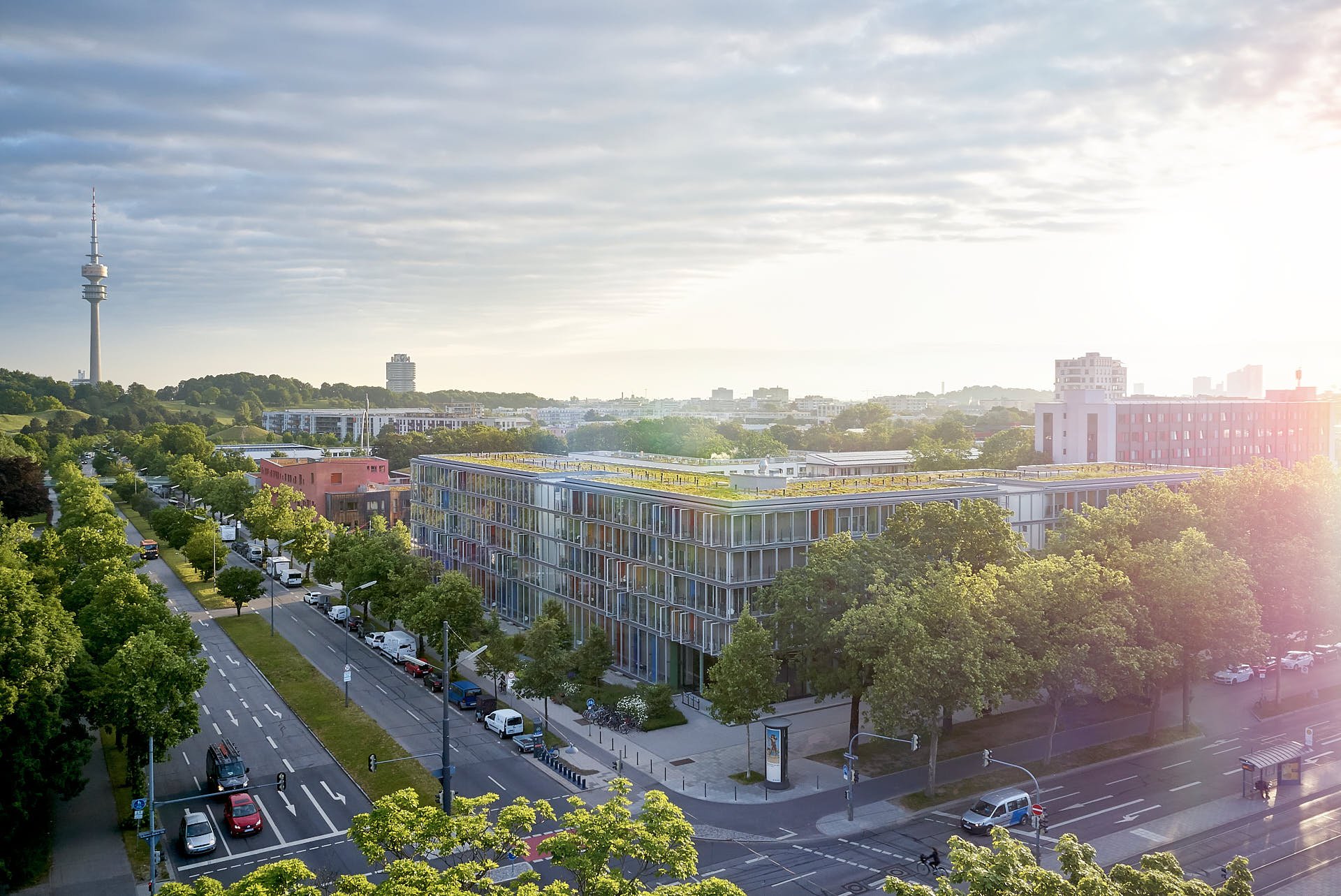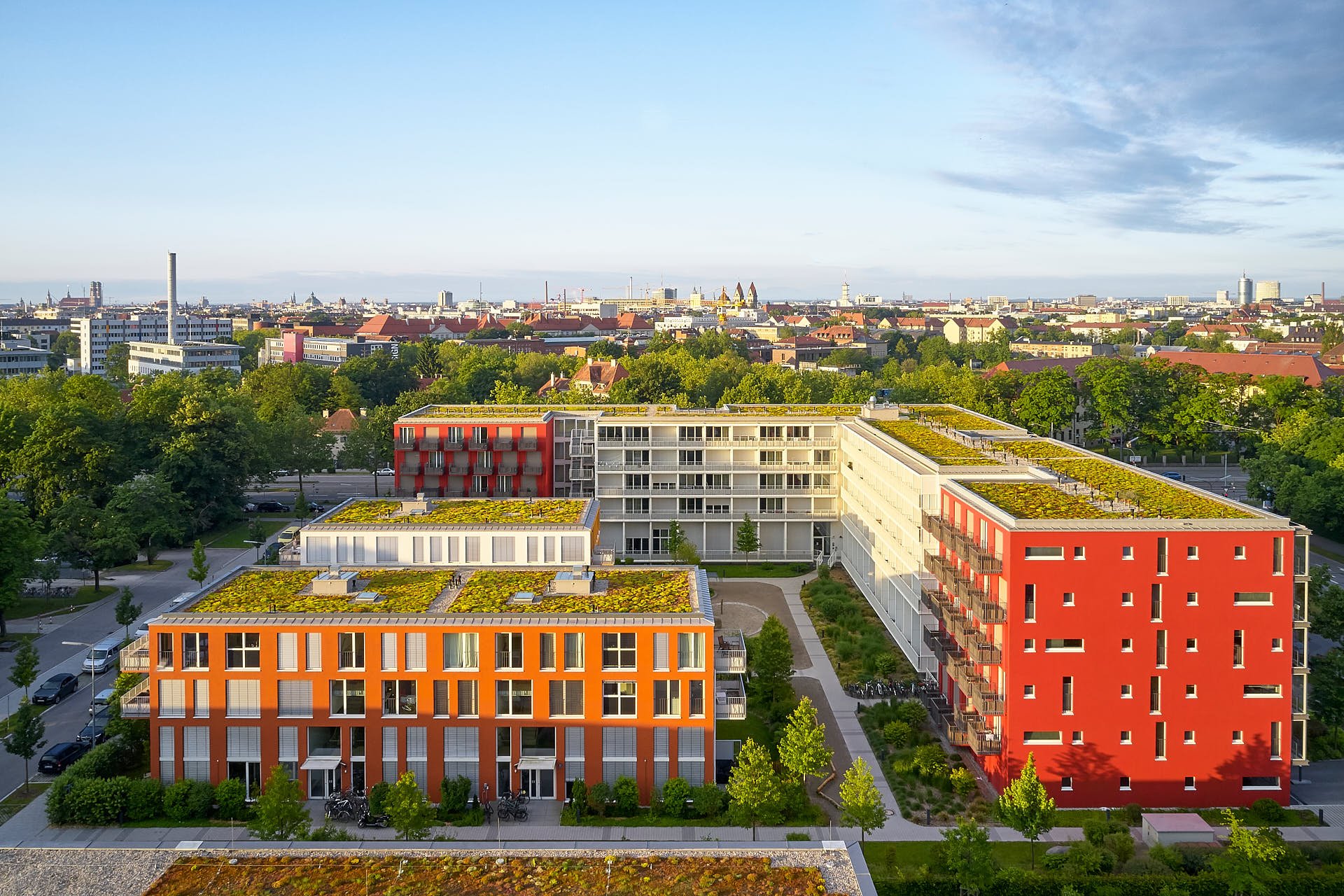Drones in Architectural Photography
Aerial photography with drones in architectural photography has been on everyone's lips for years. Most of my customers vacillate between great interest in the new shooting possibilities and great fears regarding legal security. That's why I'd like to highlight a few aspects that you should consider as a customer.
A new perspective?
Basically, all the angles that are possible with a drone were already possible before they were invented. I divide drone images into two categories: Top-down (or satellite view) and high-up.
Top-down views are very graphic images. By looking directly from above, the perspective disappears. All shapes are displayed two-dimensionally and the focus is strongly on shapes and textures. Graphic designers in particular love this view, as it is ideal for layout work as a background. These images were taken from helicopters before the drone era. In contrast to a drone, this flies at least 300m above the ground (drones are limited to 100m in Germany) and therefore has a significantly greater distance to the object, which further enhances the 2D effect. In the helicopter, the photographer can use high-resolution cameras with different lenses and thus produce higher quality images than with a drone. However, half an hour's flight often costs upwards of €2000 just for the helicopter.
With a drone, I can create the same perspectives with a few simplifications, but more on that in a moment. With high-up images, it's important to remember that higher is not always better. A few meters above the ground is often enough to see over cars, people and greenery that would otherwise block a clear view of a house. Shots from a greater height, on the other hand, are suitable for linking the object with its structural surroundings by integrating striking objects into the picture.
High-up images have all the characteristics of a classic photo. They show the building from a frontal view and come closer to our classic way of seeing. Before the drone era, I only used the neighboring buildings for architectural photos from a greater height. During my active time at BILD, it was my job to photograph the city of Leipzig from a new perspective. To do this, I stood on countless rooftops at any time of day or night to take pictures that you never see as a pedestrian. It wasn't always easy. Permits had to be obtained and opening hours had to be observed. I often gained access through private homes. Here it was a matter of luck whether the tenant was at home when I rang the doorbell. Also, not every corner has a high-rise building with the perfect view.
More flexibility
For me as an architectural photographer, drones primarily mean freedom. Regardless of the conditions on site, I can position my camera in three-dimensional space exactly where the composition of the image is best. There are no longer any restrictions due to fixed shooting locations of neighboring buildings and no negotiations with owners. This freedom of positioning provides unique perspectives in architectural photography and is what makes aerial photography so charming.
I also have the opportunity to scout the entire area around the object during a battery charge of approx. 25 minutes and then immediately photograph different perspectives around the entire building. A task that used to take several hours of work and hundreds of steps. Previously impossible shooting angles and movements also arise for video productions. A flight around the object or a dynamic ascent from ground level to the roof of the building are great ways to present a house in a completely new way. But that's a topic for another article.
A question of rights
This is where my customers often have concerns. What laws do I have to observe when filming drones? What about flying over neighboring properties? What about the personal rights of people in the picture? Of course, I am always on hand to advise my customers on questions like these.
German legislators have given a lot of thought to drone regulations in recent years and have created a legal framework. With a drone weighing up to 2 kilograms, this results in the following restrictions:
Maximum altitude of 100m above ground
General ban on night flights
Keep your distance from:
Residential properties
Nature reserves
1.5 km distance from airports
Crowds of people
Main roads
Federal waterways
Railroad facilities
Military installations
Places of operation of authorities
Industrial plants
Justice buildings
In addition, as a drone pilot I undertake to comply with the following points:
I have taken out drone liability insurance for property damage and personal injury
I mark my drone with a fireproof sticker that clearly identifies the owner
I inform myself about the regulations of the current flight area before departure
I need a drone license for drones over 250 grams from 31.12.2020. An intensive examination of regulations and the operation of the aircraft is essential to ensure safe photo production for yourself, your customers and your surroundings.
At first glance, this list of prohibitions clearly restricts the possible uses of drones. Fortunately, in practice the public authorities are usually willing to compromise. With a preparation period of at least 14 days before the shoot, you can apply for special permits that allow you to fly for several weeks. In most cases, conditions are imposed such as not flying over main traffic routes and informing certain residents about the upcoming flight. Then there is no reason not to fly in inner-city locations. The time of day also has an impact on permits. In the early morning, it is not only the light that is advantageous for the pictures. Most public places and streets are not yet busy and therefore allow a legally compliant overflight.
In reality, we see a very mixed approach to the regulations. A good example is a video that the city of Leipzig used for advertising some time ago. Here, a drone flies at dusk (night flight ban) over the ring road (flight ban over main roads) and the city center (flight ban over crowds), violating three laws in one clip. This did not stop the city from publicly promoting itself.
I think it is our job as pilots to deal responsibly with the situation at hand and to give top priority to the safety of everyone involved.
With a good choice of location and time of day, many laws can be observed. A creative approach to the restrictions often produces very special image results in architectural photography. This brings me to the next point of this article.
Further challenges
In addition to legal regulations, flying a drone entails a number of other restrictions.
This means that the drone can only be used up to a certain wind speed. At wind speeds above 30 km/h, I only fly with reservations and extreme caution, as the drone can only counteract the wind forces to a limited extent.
The temperature plays an important role in the functionality of the batteries. The battery is operated at 25°C and must be brought to the correct temperature by the drone before take-off. This can cost a large part of the flight time if the drone is poorly prepared. Temperatures in the sub-zero range also significantly shorten the battery life of the drone and the remote control.
The drone can fly in light rain, as the rotors blow most of the water away. However, droplets often get onto the camera lens and cause spots on the image.
Especially during inner-city flights, there are often interference warnings on the radio signal through which the drone communicates with the remote control. If the interference is too strong, the connection to the drone may be lost, which must be avoided at all costs.
Good to know
The camera stabilization in the latest drones is so strong that the camera can produce long exposures of several seconds in calm conditions. Anyone who has ever tried to take such a shot with their own hands will know what a challenge this is.
The biggest concern I hear from residents during photo productions is: "Now you can look into my whole apartment." I can quickly allay people's fears by showing them one of the drone's images. The contrast between the bright, sunlit exterior of a building and the dark interior is so great that you can't see through the windows in the picture. If the pretty neighbor is lolling in the sun on a deck chair on the adjacent property during the shot, a few clicks in Photoshop usually help to retouch her out of the picture to satisfy everyone involved.
Conclusion
In architectural photography, drones offer us a great addition to classic shooting options, but by no means replace them. For most architectural photography assignments, I use a drone to produce additional, unique images that are often very popular with my clients.
It is up to me and my customers to decide how we deal with legal and safety-related restrictions. Mutual understanding and a willingness to compromise are important here to ensure safe production. The result is usually a very appropriate reward for the extra work involved in the preparation.
By the way, you can find more information and pictures about the Studio Muc in Munich shown here in the corresponding project description: Studio Muc
To the Photoshooting
Client: Atelier 8
Type: Reference photos
Location: Studio Muc
Place: Munich (Bavaria), Germany







